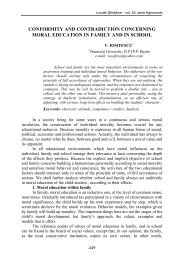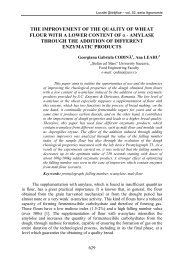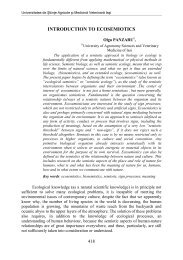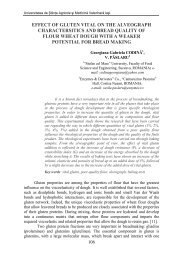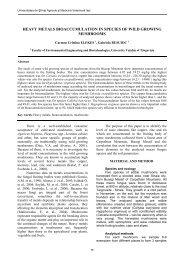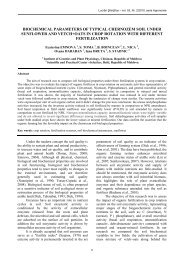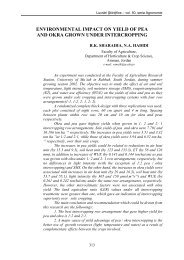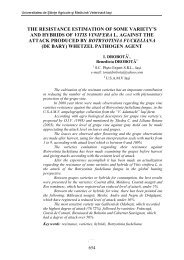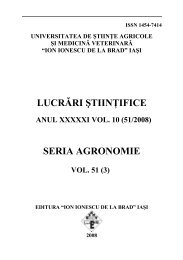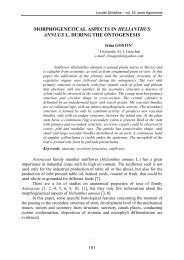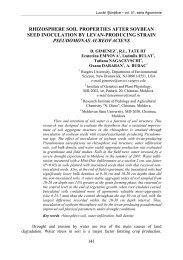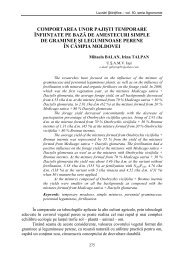ecopedological researches on soil resources from natural and ...
ecopedological researches on soil resources from natural and ...
ecopedological researches on soil resources from natural and ...
Create successful ePaper yourself
Turn your PDF publications into a flip-book with our unique Google optimized e-Paper software.
Lucrări Ştiinţifice – vol. 51, seria Agr<strong>on</strong>omie<br />
ECOPEDOLOGICAL RESEARCHES ON SOIL<br />
RESOURCES FROM NATURAL AND<br />
ANTHROPOGENIC ECOSYSTEMS FROM<br />
MOLDAVIAN PLAIN<br />
L. BIREESCU 1 , Geanina BIREESCU 1<br />
Iulia ANTON 2 , Daniela DANA 2<br />
E. TEODORESCU-SOARE 3<br />
1<br />
Biological Research Institute, Iaşi<br />
e-mail: lazarbireescu@yahoo.com<br />
2 Nati<strong>on</strong>al Research <strong>and</strong> Development Institute for<br />
Soil Science, Agrochemistry <strong>and</strong> Envir<strong>on</strong>ment,<br />
Bucharest<br />
e-mail: danadaney@yahoo.com<br />
3 University of Agriculture <strong>and</strong> Veterinary Medicine,<br />
Iaşi<br />
e-mail: eug_teod@univagro-iasi.ro<br />
As part of ecosystem, between biotope <strong>and</strong> biocenosis they achieve<br />
reversible <strong>and</strong> permanent changes of substances, energy <strong>and</strong> informati<strong>on</strong>s,<br />
depending <strong>on</strong> the local <strong>and</strong> regi<strong>on</strong>al specific. In this paper we present the<br />
results of the <str<strong>on</strong>g>ecopedological</str<strong>on</strong>g> <str<strong>on</strong>g>researches</str<strong>on</strong>g> accomplished in the <strong>natural</strong> <strong>and</strong><br />
anthropogenic pasture ecosystems located in the Moldavian Plain, Deleni,<br />
county Iasi. C<strong>on</strong>sequently, we analysed a „c<strong>on</strong>stellati<strong>on</strong>” of 20 main<br />
ecological factors <strong>and</strong> determinants, climatic <strong>and</strong> pedological, through 8<br />
classes of ecological size <strong>from</strong> a quantitative point of view <strong>and</strong> 6 classes of<br />
ecological favourability <strong>from</strong> a qualitative point of view. On the basis of the<br />
ecolgical specificity files we pointed out the main lacks <strong>and</strong> excesses, climatic<br />
<strong>and</strong> pedological of the <strong>soil</strong> <strong>resources</strong> (the summer seas<strong>on</strong> extremely drought,<br />
the hard <strong>soil</strong> c<strong>on</strong>sistency in the summer seas<strong>on</strong>, the fine texture, the low level<br />
of <strong>soil</strong> aerati<strong>on</strong>), in the ecological c<strong>on</strong>text. In additi<strong>on</strong> to this overgrazing<br />
with negative effects <strong>on</strong> the <strong>soil</strong> <strong>resources</strong>.<br />
Key words: pasture ecosystems, ecological specific, ecological specificity<br />
files, <strong>soil</strong> quality<br />
As part of ecosystem, between biotope <strong>and</strong> biocenosis they achieve<br />
reversible <strong>and</strong> permanent changes of substances, energy <strong>and</strong> informati<strong>on</strong>s,<br />
depending <strong>on</strong> the local <strong>and</strong> regi<strong>on</strong>al ecological specific. The main climatic <strong>and</strong><br />
pedologic c<strong>on</strong>stituents play the role of ecological factors <strong>and</strong> determinants, which<br />
influence, directly <strong>and</strong> indirectly, the structure <strong>and</strong> functi<strong>on</strong>ality of the biocenosis,<br />
according to the fundamental laws of the ecology: combine acti<strong>on</strong> of the factors<br />
law, tolerance law, minimum <strong>and</strong> partial compensati<strong>on</strong> law [1, 2].<br />
165
Universitatea de Ştiinţe Agricole şi Medicină Veterinară Iaşi<br />
Soil quality is defined in various ways. Implicitly, in many definiti<strong>on</strong>s of <strong>soil</strong><br />
quality there is the ideea that the most important attributes of a healthy <strong>soil</strong> vary,<br />
depending up<strong>on</strong> a human values judgement about the primary functi<strong>on</strong> of a<br />
particular <strong>soil</strong> in a specific locati<strong>on</strong>. After Kleinhenz <strong>and</strong> Bierman (2001) the <strong>soil</strong><br />
quality is defined as the capacity of a specific kind of <strong>soil</strong> to functi<strong>on</strong>, within<br />
<strong>natural</strong> or managed ecosystem boundaries, to sustain plant <strong>and</strong> animal productivity,<br />
maintain the water <strong>and</strong> the air quality <strong>and</strong> support the human health <strong>and</strong> habitati<strong>on</strong>.<br />
The <strong>soil</strong> quality is a composite picture of the c<strong>on</strong>diti<strong>on</strong> of a specific <strong>soil</strong> to functi<strong>on</strong><br />
for a specific use. Simply put, the <strong>soil</strong> quality is the capacity of the <strong>soil</strong> to functi<strong>on</strong><br />
[11, 7] <strong>and</strong>, also, it is an integrati<strong>on</strong> of the kind of <strong>soil</strong>, it is <strong>natural</strong> ability to<br />
functi<strong>on</strong> <strong>and</strong> it is use <strong>and</strong> management [9]. Soil quality evaluati<strong>on</strong> is a tool to assess<br />
management-induced changes in the <strong>soil</strong> <strong>and</strong> to link existing resource c<strong>on</strong>cerns to<br />
envir<strong>on</strong>mentally sound l<strong>and</strong> management practices [6].<br />
The indicators of <strong>soil</strong> quality were initialy developed to provide informati<strong>on</strong><br />
<strong>on</strong> the suitability <strong>and</strong> relative value of l<strong>and</strong> for different types of agricultural<br />
producti<strong>on</strong>. More recently, the indicators have been developed to provide<br />
informati<strong>on</strong> <strong>on</strong> the impacts of agricultural practices <strong>on</strong> l<strong>and</strong> <strong>and</strong> envir<strong>on</strong>mental<br />
degradati<strong>on</strong> [3]. Soil quality assessment tipically included the quantificati<strong>on</strong> of<br />
indicators that are often derived <strong>from</strong> reducti<strong>on</strong>ist studies or general qualitative<br />
observati<strong>on</strong>s of the <strong>soil</strong>. Overall, <strong>soil</strong> quality indicators c<strong>on</strong>dense the enormous<br />
complexity of the <strong>soil</strong> [12, 13].<br />
The main objectives of our <str<strong>on</strong>g>researches</str<strong>on</strong>g> are:<br />
- Complex interdisciplinary ecological study up<strong>on</strong> the present state of the<br />
<strong>soil</strong> <strong>resources</strong> in view of the protecti<strong>on</strong> of the <strong>soil</strong>s quality <strong>and</strong> for the sustainable<br />
utilizati<strong>on</strong> of the <strong>natural</strong> <strong>resources</strong>;<br />
- M<strong>on</strong>itoring of the actual state of quality <strong>and</strong> evolutive dynamic of the <strong>soil</strong><br />
<strong>resources</strong>;<br />
- Elaborating of the thematic proposals <strong>and</strong> strategies with the object of the<br />
<strong>soil</strong> <strong>resources</strong> quality protecti<strong>on</strong>, c<strong>on</strong>serving, ameliorati<strong>on</strong>, ecological remedy of<br />
deteriorated fields <strong>and</strong> sustainable utilisati<strong>on</strong>.<br />
MATERIALS AND METHODS<br />
Our <str<strong>on</strong>g>researches</str<strong>on</strong>g> was accomplished in the <strong>natural</strong> <strong>and</strong> anthropogenic influenced<br />
pasture ecosystems, located in North Eastern of Romania, in the Moldavian Plain,<br />
Deleni, county Iasi. The <strong>soil</strong>s are Vertic Chernozem in the <strong>natural</strong> pasture <strong>and</strong> Haplic<br />
Chernozem in the anthropogenic influenced pasture. The <strong>soil</strong> samples were taken <strong>from</strong><br />
the <strong>soil</strong> profiles of different genetic horiz<strong>on</strong>s <strong>and</strong> they have been analysed in the field<br />
<strong>and</strong> laboratory, according to the specific methods proposed by Nati<strong>on</strong>al Research <strong>and</strong><br />
Development Institute for Soil Science, Agrochemistry <strong>and</strong> Envir<strong>on</strong>ment, Bucharest,<br />
Romania (1987). On the basis of the physical <strong>and</strong> chemical properties of the <strong>soil</strong>s <strong>and</strong><br />
ecological c<strong>on</strong>text, we elaborated the ecological specificity files, accordingly with Chirita<br />
(1974) <strong>and</strong> improved by Bireescu et al. (2005, 2007). C<strong>on</strong>sequently, we analysed a<br />
„c<strong>on</strong>stellati<strong>on</strong>” of 20 main ecological factors <strong>and</strong> determinants, climatic <strong>and</strong> pedological:<br />
166
Lucrări Ştiinţifice – vol. 51, seria Agr<strong>on</strong>omie<br />
- 5 z<strong>on</strong>e <strong>and</strong> local climatic factors: annual average temperature (T 0 C), annual<br />
average precipitati<strong>on</strong>s (Pmm), winds (W), summer precipitati<strong>on</strong>s (Pe) <strong>and</strong> summer<br />
relative humidity (Uer);<br />
- 15 pedo-ecological factors <strong>and</strong> determinants: 3 growing factors (total nitrogen<br />
c<strong>on</strong>tent-Nt, available phosphorus c<strong>on</strong>tent-P <strong>and</strong> exchangeable potassium c<strong>on</strong>tent-K); 2<br />
<str<strong>on</strong>g>ecopedological</str<strong>on</strong>g> factors of space <strong>and</strong> time (edaphic volume-Ve <strong>and</strong> bioactive length<br />
period-BLP); 2 negative <str<strong>on</strong>g>ecopedological</str<strong>on</strong>g> factors (alkality/acidity-Alk-Ac <strong>and</strong> the summer<br />
c<strong>on</strong>sistency of the <strong>soil</strong>-C<strong>on</strong>); 5 <str<strong>on</strong>g>ecopedological</str<strong>on</strong>g> determinants (Soil Organic Matter<br />
c<strong>on</strong>tent-SOM, <strong>soil</strong> texture-Tx, air porosity of the <strong>soil</strong>-AP, <strong>soil</strong> reacti<strong>on</strong>-pH H2O <strong>and</strong> base<br />
saturati<strong>on</strong>-BS), 1 pedo-biological indicator (biological activity-Bio) <strong>and</strong> 2 pedological<br />
synthetic indicators of trophycity (Potential Trophycity-PT <strong>and</strong> Effective Trophycity-ET).<br />
These main <str<strong>on</strong>g>ecopedological</str<strong>on</strong>g> factors <strong>and</strong> determinants have been characterized<br />
<strong>from</strong> a quantitative (in 8 ecological size classes: 0 ... m-lack ... minimum, I, II, III, IV, V,<br />
E 1 -excessive with restricting effects <strong>on</strong> plants <strong>and</strong> E 2 -excessive with toxic effects <strong>on</strong><br />
plants) <strong>and</strong> qualitative (in 6 ecological favourability classes: 0 ... m-lack ... minimum,<br />
VL-Very Low, L-Low, M-Medium, H-High <strong>and</strong> VH-Very High) point of view, according to<br />
the specific ecological criteria.<br />
RESULTS AND DISCUSSIONS<br />
a) The study of <strong>soil</strong> profiles <strong>on</strong> genetic horiz<strong>on</strong>s<br />
The analysis of the main physical, chemical <strong>and</strong> biological features of <strong>soil</strong><br />
<strong>resources</strong> (Vertic Chernozem <strong>and</strong> Haplic Chernozem) (tab. 1) <strong>from</strong> pasture<br />
ecosystems (<strong>natural</strong> <strong>and</strong> anthropogenic influenced) allows:<br />
- <strong>soil</strong> texture is medium-fine (33.2% clay in Am horiz<strong>on</strong> <strong>from</strong> Vertic<br />
Chernozem <strong>and</strong> 34.8% clay in Am horiz<strong>on</strong> <strong>from</strong> Haplic Chernozem);<br />
- values of air porosity (AP) are low <strong>and</strong> very low (10.3-11.5% <strong>and</strong> 6.1-9.4%<br />
in the first 40 cm <strong>from</strong> Vertic Chernozem <strong>and</strong> Haplic Chernozem);<br />
- <strong>soil</strong> reacti<strong>on</strong> (pH H2O ) is low alkaline (7.1-8.3 pH units) in the Vertic<br />
Chernozem <strong>and</strong> neutral (6.8-7.2) in the Haplic Chernozem;<br />
- Soil Organic Matter (SOM) c<strong>on</strong>tent has a little higher values in the Vertic<br />
Chernozem (3.912% in the first 20 cm) <strong>and</strong> a little lower values (3.384% in the<br />
first 20 cm) in the Haplic Chernozem;<br />
- total nitrogen c<strong>on</strong>tent (Nt) has a little higher values in the Vertic<br />
Chernozem (0.178-0.153%) <strong>and</strong> a little lower values (0.141-0.101%) in the Haplic<br />
Chernozem;<br />
- available phosphorus c<strong>on</strong>tent (P AL ) has high values in the both of <strong>soil</strong>s (86-<br />
64 ppm in the Vertic Chernozem <strong>and</strong> 51-35 ppm in the Haplic Chernozem);<br />
- exchangeable potassium c<strong>on</strong>tent (K AL ) has moderate values in the both of<br />
<strong>soil</strong>s (182-165 ppm in the Vertic Chernozem <strong>and</strong> 177-158 ppm in the Haplic<br />
Chernozem);<br />
- sum of exchangeable bases (SEB) has moderate values in the both of <strong>soil</strong>s<br />
(22.4-20.4 me in the Vertic Chernozem <strong>and</strong> 19.3-17.3 me in the Haplic<br />
Chernozem);<br />
- cati<strong>on</strong> exchange capacity (T) has moderate values in the both of <strong>soil</strong>s (23.8-<br />
20.4 me in the Vertic Chernozem <strong>and</strong> 21.5-17.3 me in the Haplic Chernozem);<br />
- base saturati<strong>on</strong> percentage (BS) has high values in the both of <strong>soil</strong>s;<br />
167
Universitatea de Ştiinţe Agricole şi Medicină Veterinară Iaşi<br />
Table 1<br />
The main physical, chemical <strong>and</strong> biological features of <strong>soil</strong> <strong>resources</strong> <strong>from</strong><br />
pasture ecosystems<br />
Features<br />
The first profile: Vertic<br />
Chernozem – <strong>natural</strong> pasture<br />
The sec<strong>on</strong>d profile: Haplic<br />
Chernozem – anthropogenic<br />
influenced pasture<br />
Am<br />
(0-20)<br />
A/Cy<br />
(20-40)<br />
Ccay<br />
(40-90)<br />
Am<br />
(0-20)<br />
A/C<br />
(20-40)<br />
Cca<br />
(40-90)<br />
Clay (%) 33.2 30.5 26.4 34.8 31.1 28.3<br />
Air porosity 10.3 11.5 15.8 6.1 9.4 13.7<br />
pH H2O 7.1 7.7 8.3 6.8 7.0 7.2<br />
SOM (%) 3.912 2.971 0.917 3.384 2.106 0.701<br />
Nt (%) 0.178 0.153 0.082 0.141 0.101 0.045<br />
P AL (ppm) 86 77 64 51 42 35<br />
K AL (ppm) 182 177 165 177 161 158<br />
SEB (me) 22.4 24.1 20.4 19.3 20.4 17.3<br />
T (me) 23.8 24.1 20.4 21.5 21.6 17.3<br />
BS (%) 99 100 100 93 95 100<br />
PT (points) 70 54 24 70 45 20<br />
- potential trophycity (PT) has high values in the Vertic Chernozem (148<br />
points) <strong>and</strong> medium values in the Haplic Chernozem (115 points); in spite of these<br />
values, the trophy c<strong>on</strong>tent cannot turned to good account, especially in the summer<br />
seas<strong>on</strong>, excessive droughty.<br />
b. The ecological specificity files of the ecopedotopes<br />
The knowledge of the physical, chemical <strong>and</strong> biological features of the <strong>soil</strong><br />
is an essential criteri<strong>on</strong> for the elaborati<strong>on</strong> of the ecological specificity file, as an<br />
indicator of <strong>soil</strong> quality. In this way, many studies showed that <strong>soil</strong> quality<br />
describes the combinati<strong>on</strong> of physical, chemical <strong>and</strong> biological characteristics that<br />
enables to perform a wide range of functi<strong>on</strong>s [5, 14]. Also, proposed methods for<br />
measuring <strong>soil</strong> quality use <strong>soil</strong> properties or indicators that reflect the capacity of<br />
<strong>soil</strong> to functi<strong>on</strong> [9, 11]. The analysis of the ecological specificity files (tab. 2, 3)<br />
pointed out that the majority of ecological factors <strong>and</strong> determinants (Nt, P, K<br />
c<strong>on</strong>tents, SOM c<strong>on</strong>tent, annual average temperature, annual average precipitati<strong>on</strong>s,<br />
<strong>soil</strong> texture, <strong>soil</strong> reacti<strong>on</strong>, biological activity, potential trophycity <strong>and</strong> effective<br />
trophycity) are classified into the medium classes of ecological size (III <strong>and</strong> IV).<br />
The c<strong>on</strong>tent of qualities of the Vertic Chernozem (<strong>natural</strong> pasture) <strong>and</strong> Haplic<br />
Chernozem (anthropogenic influenced pasture) is high, but, in the z<strong>on</strong>e <strong>and</strong><br />
regi<strong>on</strong>al c<strong>on</strong>text, cannot turned to good account, especially in the summer seas<strong>on</strong><br />
excessive droughty. They distinguish the following limitative ecological factors<br />
<strong>and</strong> determinants:<br />
- low level (in the Vertic Chernozem) <strong>and</strong> very low level (in the Haplic<br />
Chernozem) of air porosity, because of overgrazing which leads to treading of the<br />
<strong>soil</strong> in the <strong>natural</strong> pasture;<br />
- the very low level of summer precipitati<strong>on</strong>s <strong>and</strong> summer relative humidity;<br />
168
Lucrări Ştiinţifice – vol. 51, seria Agr<strong>on</strong>omie<br />
Table 2<br />
Ecological size classes of the <str<strong>on</strong>g>ecopedological</str<strong>on</strong>g> factors <strong>and</strong> determinants-pasture<br />
ecosystems-Deleni- Iasi<br />
Eco-pedological<br />
Size classes<br />
factors <strong>and</strong> determinants 0…m I II III IV V E 1 E 2<br />
Total N c<strong>on</strong>tent (Nt) ▲ ☼<br />
Available P (P) ▲ ☼<br />
Exchangeable K (K)<br />
☼▲<br />
Annual average temp. (T 0 C)<br />
☼▲<br />
Annual average precipit. (Pmm)<br />
☼▲<br />
Winds (W)<br />
☼▲<br />
Summer precipitati<strong>on</strong>s (Pe)<br />
☼▲<br />
Summer relative humidity (Uer)<br />
☼▲<br />
Edaphic volume (Ve) ▲ ☼<br />
Bioactive length period (BLP)<br />
☼▲<br />
Alkality/Acidity (Alk)<br />
☼▲<br />
Summer c<strong>on</strong>sistency (C<strong>on</strong>)<br />
☼▲<br />
Soil Organic Matter (SOM) ▲ ☼<br />
Soil texture (Tx) ▲ ☼<br />
Air porosity of <strong>soil</strong> (PA) ▲ ☼<br />
Soil reacti<strong>on</strong> (pH) ▲ ☼<br />
Base saturati<strong>on</strong> (BS) ▲ ☼<br />
The biological activity (Bio) ▲ ☼<br />
Potential trophicity (PT) ▲ ☼<br />
Effective trophicity (ET) ▲ ☼<br />
Legend:<br />
☼ Natural pasture (Vertic Chernozem)<br />
▲ Anthropogenic influenced pasture (Haplic Chernozem)<br />
Also, they distinguish the high values of base saturati<strong>on</strong> percentage, edaphic<br />
volume <strong>and</strong> bioactive length period. The high level of the summer c<strong>on</strong>sistency of<br />
the dry <strong>soil</strong> are classified into the E 1 class of ecological size (excessive with<br />
restricting effects <strong>on</strong> plants).<br />
Reffering to the ecological favourability, the majority of ecological factors<br />
<strong>and</strong> determinants (the same as classes of ecological size) are classified into the<br />
medium <strong>and</strong> high classes of ecological favourability. The summer seas<strong>on</strong> excessive<br />
droughty, the high level of the summer c<strong>on</strong>sistency of dry <strong>soil</strong> <strong>and</strong> the low level of<br />
air porosity are classified into the very low class of ecological favourability. The<br />
high c<strong>on</strong>tent of available phosphorus c<strong>on</strong>tent, annual average temperature, the high<br />
level of pedological factors <strong>and</strong> bioactive length period, <strong>soil</strong> reacti<strong>on</strong>, base<br />
saturati<strong>on</strong>, potential trophycity are classified into the very high class of ecological<br />
favourability. Potential trophycity is very high in the <strong>natural</strong> pasture <strong>and</strong> high in the<br />
anthropogenic influenced pasture. Effective trophycity is diminished in the summer<br />
seas<strong>on</strong> because of excessive drought <strong>and</strong> it is classified into the high class of<br />
ecological favourability in case of <strong>natural</strong> pasture <strong>and</strong> into the medium class of<br />
ecological favourability in case of anthropogenic influenced pasture.<br />
169
Universitatea de Ştiinţe Agricole şi Medicină Veterinară Iaşi<br />
Table 3<br />
Ecological favourability classes of the eco-pedological factors <strong>and</strong><br />
determinants-pasture ecosystems-Deleni- Iasi<br />
Eco-pedological<br />
Favourability classes<br />
factors <strong>and</strong> feterminants N...m VL L M H VH<br />
Total N c<strong>on</strong>tent (Nt) ▲ ☼<br />
Available P c<strong>on</strong>tent (P) ▲ ☼<br />
Exchangeable K (K) ▲ ☼<br />
Annual average temp. (T 0 C)<br />
☼▲<br />
Annual average precipit. (Pmm)<br />
☼▲<br />
Winds (W)<br />
☼▲<br />
Summer precipitati<strong>on</strong>s (Pe)<br />
☼▲<br />
Summer relative humidity (Uer)<br />
☼▲<br />
Edaphic volume (Ve) ▲ ☼<br />
Bioactive length period (BLP)<br />
☼▲<br />
Alkality/Acidity (Alk)<br />
☼▲<br />
Summer c<strong>on</strong>sistensy (C<strong>on</strong>) ▲ ☼<br />
Soil Organic Matter (SOM) ▲ ☼<br />
Soil texture (Tx)<br />
☼▲<br />
Air porosity of <strong>soil</strong> (PA) ▲ ☼<br />
Soil reacti<strong>on</strong> (pH) ▲ ☼<br />
Base saturati<strong>on</strong> (BS) ▲ ☼<br />
Biological activity (Bio) ▲ ☼<br />
Potential trophicity (PT) ▲ ☼<br />
Effective trophicity (ET) ▲ ☼<br />
Legend<br />
☼ Natural pasture (Vertic Chernozem)<br />
▲ Anthropogenic influenced pasture (Haplic Chernozem)<br />
Roughly, it has been found that the <strong>soil</strong> quality indicators <strong>from</strong> <strong>natural</strong><br />
pasture (Vertic Chernozem) are superior to the anthropogenic influenced pasture<br />
(Haplic Chernozem). The reas<strong>on</strong>s are overgrazing, the lack of the managing<br />
pasture <strong>and</strong> the treading of the <strong>soil</strong>. The complex analysis of the <strong>soil</strong> <strong>resources</strong> in<br />
the ecological c<strong>on</strong>text pointed out the negative anthropogenic impact <strong>on</strong> the Haplic<br />
Chernozem (anthropogenic influenced pasture). Thus, to distinguish numerous<br />
negative ecological effects (treading of the <strong>soil</strong>, the ruderalizati<strong>on</strong> of the pasture,<br />
the decrease of biodiversity, the destructi<strong>on</strong> of <strong>soil</strong> structure, the decrease of<br />
biological activity of the <strong>soil</strong>) which lead to the degradati<strong>on</strong> of <strong>soil</strong> <strong>and</strong> vegetati<strong>on</strong><br />
quality. The negative ecological effects, al<strong>on</strong>gside of climatical factor (summer<br />
seas<strong>on</strong> excessive droughty) <strong>and</strong> pedological factors (summer c<strong>on</strong>sistency of the dry<br />
<strong>soil</strong>, low level of air porosity) of negative impact must m<strong>on</strong>itoring so that, <strong>on</strong> the<br />
basis of quality indicators to estabilish the measures <strong>and</strong> the strategies of<br />
improvement, c<strong>on</strong>servati<strong>on</strong> <strong>and</strong> rehabilitati<strong>on</strong> of the <strong>soil</strong> <strong>resources</strong>. Also, it is<br />
indispensable taking into account the protecting measures of envir<strong>on</strong>ment <strong>and</strong><br />
biodiversity for sustainable utilizati<strong>on</strong> of <strong>soil</strong> <strong>and</strong> vegetati<strong>on</strong> <strong>resources</strong>.<br />
170
Lucrări Ştiinţifice – vol. 51, seria Agr<strong>on</strong>omie<br />
CONCLUSIONS<br />
1.) Ecopedological study of the biotope has the role to develop, <strong>from</strong> a<br />
quantitative <strong>and</strong> qualitative point of view, the whole complex of pedological<br />
factors, in order to defining the qualities, lacks or excess c<strong>on</strong>tent, which the <strong>soil</strong><br />
offer them to biocenosis, correlated with the elements of ecological specific.<br />
2.) Ecological specificity file of the <strong>natural</strong> <strong>and</strong> anthropogenic influenced<br />
pasture ecopedotopes pointed out, <strong>from</strong> a quantitative <strong>and</strong> qualitative point of view,<br />
the ecological limitative factors, through lack or excess, against to intervene with a<br />
sustainable management. The low levels of summer precipitati<strong>on</strong>s, summer relative<br />
humidity <strong>and</strong> air porosity of the <strong>soil</strong> are classified into the first (I) <strong>and</strong> the sec<strong>on</strong>d<br />
(II) classes of ecological size. The majority of ecological factors <strong>and</strong> determinants<br />
are classified into the medium classes of ecological size (III <strong>and</strong> IV) <strong>and</strong> medium to<br />
high favourability classes for the pasture ecosystems. The high level of the summer<br />
c<strong>on</strong>sistency of the dry <strong>soil</strong> is classified into the E 1 class of ecological size<br />
(excessive with restricting effects <strong>on</strong> plants).<br />
3.) The valuati<strong>on</strong>, <strong>from</strong> qualitative point of view of the favourability of<br />
pedoclimatical c<strong>on</strong>diti<strong>on</strong>s pointed out, <strong>on</strong> the <strong>on</strong>e h<strong>and</strong>, a very low favourability<br />
because of summer seas<strong>on</strong> excessive droughty, hard summer c<strong>on</strong>sistency of the <strong>soil</strong><br />
<strong>and</strong> low level of air porosity <strong>and</strong>, <strong>on</strong> the other h<strong>and</strong>, a medium favourability of the<br />
biological activity <strong>and</strong> medium-fine texture of the <strong>soil</strong>.<br />
4.) In the <strong>natural</strong> pasture, the main indicators of negative impact are the<br />
overgrazing <strong>and</strong> the lack of the managing pasture. The main ecological negative<br />
effects are treading of the <strong>soil</strong>, the decrease of biodiversity, the destructi<strong>on</strong> of <strong>soil</strong><br />
structure, the ruderalizati<strong>on</strong> of the pasture <strong>and</strong> the decrease of biological activity of<br />
the <strong>soil</strong>. The m<strong>on</strong>itoring of the <strong>soil</strong> quality indicators development will allow the<br />
establishing of the strategy <strong>and</strong> prognose framework for the biodiversity <strong>and</strong><br />
envir<strong>on</strong>mental protecti<strong>on</strong> <strong>and</strong> the sustainability of <strong>soil</strong> <strong>resources</strong>.<br />
BIBLIOGRAPHY<br />
1. Bireescu, L., Bireescu, Geanina, Lupaşcu, G., Secu, C., Breabăn, Iuliana, 2005 -<br />
Interpretarea ecologică a solului şi evaluarea impactului ecologic global în<br />
ecosisteme praticole situate pe terenuri degradate din Podişul Bârladului, Lucr. şt.<br />
C<strong>on</strong>f. Naţ. Şt. Sol., Timişoara, 2003, vol. 2, nr. 34 B, p. 473-481.<br />
2. Bireescu, Geanina, Bireescu, L., Lupaşcu, G., Breabăn, Iuliana, Lupaşcu, Angela,<br />
Teodorescu, E., 2007 – Ecopedological study over <strong>soil</strong> <strong>resources</strong> in forest<br />
ecosystems <strong>from</strong> Moldavian Plain, Lucr. şt. USAMV Iaşi, seria Horticultură, anul L.,<br />
vol. 1 (50), p. 863-870.<br />
3. Bremer, E., Ellert, K., 2004 – Soil Quality Indicators: a review with implicati<strong>on</strong>s for<br />
agricultural ecosystems in Alberta, Envir<strong>on</strong>mentally Sustainable Agriculture, Soil<br />
Quality Program, Alberta, Agriculture, Food <strong>and</strong> Rural Development, p.1-32.<br />
4. Chiriţă, C., 1974 – Ecopedologie cu elemente de pedologie generală, Ed. Ceres,<br />
Bucureşti.<br />
5. Evanylo, G., McGuinn, R., 2000 – Agricultural Management Practices <strong>and</strong> Soil Quality:<br />
measuring, assessing <strong>and</strong> comparing laboratory <strong>and</strong> field test kit indicators of <strong>soil</strong><br />
quality attributes, Rev. Virginia Cooperative Extensi<strong>on</strong>-Virginia Polytechnic Institute<br />
<strong>and</strong> State University, USA, no. 452/2000, p. 1-13.<br />
171
Universitatea de Ştiinţe Agricole şi Medicină Veterinară Iaşi<br />
6. Florea N., Bălăceanu C., Răuţă C., Canarache A. (redactori şi coord<strong>on</strong>atori), 1987 –<br />
Ministerul Agriculturii, Academia de Ştiinţe Agricole şi Silvice, Institutul de Cercetări<br />
pentru Pedologie şi Agrochimie: Metodologia elaborării studiilor pedologice, Redacţia<br />
de Propag<strong>and</strong>ă Tehnică Agricolă, Bucureşti.<br />
7. Friedmann, D., Hubbs, M., Tugel, A., Seybold, C., Sucik, M., 2001 – Guidelines for Soil<br />
Quality Assessment in C<strong>on</strong>servati<strong>on</strong> Planning, USDA, Natural Resources<br />
C<strong>on</strong>servati<strong>on</strong> Service Soil Quality Institute.<br />
8. Karlen, D.L., Mausbach, J.M., Doran, J.W., Cline, R.G., Harris, R.F., Schuman, G.E.,<br />
1997 – Soil Quality: A C<strong>on</strong>cept, Definiti<strong>on</strong> <strong>and</strong> Framework for Evaluati<strong>on</strong>, Soil<br />
Science Soc. Amer. Journal, no. 61, p. 4-10.<br />
9. Kleinhenz, M.D., Bierman, P.H., 2001 – Soil Quality in Vegetable <strong>and</strong> Small Fruit<br />
Producti<strong>on</strong>, Bulletin 898/2001, University Ohio State, USA.<br />
10. Mausbach, J.M., 1996 – Soil Quality C<strong>on</strong>siderati<strong>on</strong>s in the C<strong>on</strong>versi<strong>on</strong> of CRP L<strong>and</strong> to<br />
Crop Producti<strong>on</strong>, Rev. Nati<strong>on</strong>al Research Council, October, 1996, Amarillo, Texas,<br />
USA.<br />
11. Pierce, F.J., Lars<strong>on</strong>, W.E., 1993 – Developing criteria to evaluate sustainable l<strong>and</strong><br />
management, In: J.M. Kimble (ed.), Proceeding of the 8 Internati<strong>on</strong>al Soil<br />
Management Workshop: Utilizati<strong>on</strong> of Soil Survey Informati<strong>on</strong> for Sustainable L<strong>and</strong><br />
Use, May, 1993, USDA Soil C<strong>on</strong>servati<strong>on</strong> service, Nati<strong>on</strong>al Soil Survey Center,<br />
Lincoln, N.E., USA.<br />
12. Romanya, J., Serrasobes, I., Vallejo, R.V., 2002 – Indicators of Soil Quality: Definying a<br />
framework to measure <strong>soil</strong> quality, Project Record P5-053/PR/2002-Research <strong>and</strong><br />
Development: Identificati<strong>on</strong> <strong>and</strong> Development of a set of Natural Indicators for Soil<br />
Quality.<br />
13. Schj<strong>on</strong>ning, P., Elmholt, S., Christensen, B.T., 2004 – Soil Quality Management:<br />
C<strong>on</strong>cept <strong>and</strong> Term, In: Schj<strong>on</strong>ning P., Elmholt S., Christensen B.T. (eds.),<br />
Challenges in modern agriculture, CAB Internati<strong>on</strong>al, p. 1-15.<br />
14. Seybold, C.A., Mausbach, J.M., Karlen, D.L., Rogers, H.H., 1997 – Quantificati<strong>on</strong> of <strong>soil</strong><br />
quality, In: Lal R., Kimble J.M., Follet S. (eds.), Soil Processes <strong>and</strong> the Carb<strong>on</strong> Cycle,<br />
CRC Press Washingt<strong>on</strong> D.C., USA.<br />
172




